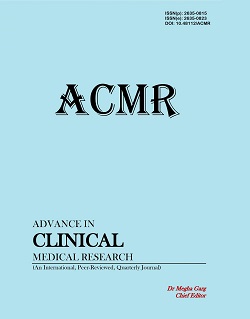Prevalence and Associations of Psychiatric Comorbidities Among Opioid Users in Bangladesh
Psychiatric Comorbidities Among Opioid Users
Keywords:
Psychiatric comorbidities, substance use disorder, major depressive disorder, generalized anxiety disorder, post-traumatic stress disorderAbstract
 Abstract Views: 134
Abstract Views: 134
Background: Opioid addiction is a growing concern in Bangladesh, affecting many with substance use disorders. Besides physical health issues, opioid injectors often face psychiatric comorbidities, complicating treatment. This study assesses the prevalence of psychiatric disorders among opioid injectors in Dhaka. Materials and Methods: A descriptive cross-sectional study was conducted between July 2024 and December 2024 at two rehabilitation centers in Dhaka. A total of 165 opioid injectors participated, with data collected through face-to-face interviews using structured questionnaires. Socio-demographic details, substance use history, and psychiatric comorbidities were assessed. Statistical analysis was performed using SPSS version 21, with descriptive statistics and chi-square tests to explore relationships between demographic factors and psychiatric disorders. Results: The study found that 66.7% of the participants were male, and the majority (66.7%) were aged between 18-29 years. The most prevalent psychiatric disorders among opioid injectors were substance use disorder (40%) and major depressive disorder (25%). Other significant psychiatric conditions included generalized anxiety disorder (18%), PTSD (15%), and suicidality (20%). Associations were found between specific opioids (e.g., codeine, tramadol) and psychiatric comorbidities, with poly-substance use showing the strongest link (OR: 11.16). Additionally, sedative use was significantly associated with major depressive disorder and obsessive-compulsive disorder. Conclusions: The findings highlight a significant mental health burden among opioid injectors in Bangladesh, with high rates of psychiatric issues like major depressive disorder and substance use disorder. The study emphasizes the need for integrated treatment to address both substance use and mental health to improve outcomes.
References
World Health Organization. Global status report on alcohol and health 2018. World Health Organization; 2018.
Patel V. Mental health in low-and middle-income countries. British medical bulletin. 2007 Jan 1;81(1):81-96.
Mørkved N, Winje D, Dovran A, Arefjord K, Johnsen E, Kroken RA, Anda-Ågotnes LG, Thimm JC, Sinkeviciute I, Rettenbacher M, Løberg EM. Childhood trauma in schizophrenia spectrum disorders as compared to substance abuse disorders. Psychiatry research. 2018 Mar 1; 261:481-7.
Livingston TD. Examining Factors Among People with Opioid Use Disorder and Comorbid Mental Health Disorders (Doctoral dissertation, The University of Texas Rio Grande Valley).
Hancq ES, South K, Vencel M. Dual diagnosis: Serious mental illness and co-occurring substance. 2021 Mar.
Rani P, Kaur A. A Problem of Substance Abuse in India: Causes and Consequences. Journal of Agricultural Development and Policy. 2024;34(1):174-81.
Vidyasagaran AL, McDaid D, Faisal MR, Nasir M, Muliyala KP, Thekkumkara S, Wright J, Huque R, Benkalkar S, Siddiqi N. Prevalence of mental disorders in South Asia: A systematic review of reviews. Glob Ment Health (Camb). 2023 Nov 13;10: e78.
Sharma MK, Chaturvedi SK. Development and validation of NIMHANS screening tool for psychological problems in Indian context. Asian J Psychiatr. 2014 Aug; 10:33-8.
Fortini S, Costanzo E, Rellini E, Amore F, Mariotti SP, Varano M, Parravano M, Virgili G, Bandello F, Rizzo S, Turco S. Use of the Patient Health Questionnaire-9 (PHQ-9) and Generalized Anxiety Disorder-7 (GAD-7) questionnaires for clinical decision-making and psychological referral in ophthalmic care: a multicentre observational study. BMJ open. 2024 Jan 1;14(1):e075141.
Saini R, Parmar A, Rao R, Mishra AK, Ambekar A, Agrawal A. Psychiatric and substance use comorbidities among people who inject drugs in India: A cross-sectional, community-based study. World Social Psychiatry. 2021 Sep 1;3(3):195-202.
Zeziulin O, Mollan KR, Shook-Sa BE, Hanscom B, Lancaster KE, Dumchev K, Go VF, Chu VA, Kiriazova T, Syarif Z, Dvoryak S, Reifeis SA, Hamilton E, Sarasvita R, Rose S, Richardson P, Clarke W, Latkin CA, Metzger DS, Hoffman IF, Miller WC. Depressive symptoms and use of HIV care and medication-assisted treatment among people with HIV who inject drugs. AIDS. 2021 Mar 1;35(3):495-501.
Compton III WM, Cottler LB, Jacobs JL, Ben-Abdallah A, Spitznagel EL. The role of psychiatric disorders in predicting drug dependence treatment outcomes. American Journal of Psychiatry. 2003 May 1;160(5):890-5.
Mackesy-Amiti ME, Donenberg GR, Ouellet LJ. Prevalence of psychiatric disorders among young injection drug users. Drug Alcohol Depend. 2012 Jul 1;124(1-2):70-8.
Ahmed HU, Alam MT, Sarkar M, Alam MF, Hossain MD, Bhowmik AD, Khan NM, Uddin MJ, Royle RK, Khan MZ, Sarkar AA. Psychiatric comorbidity among the patients with substance use disorders in Bangladesh. Archives of NIMH. 2020;3(1):7-12.
Maruf MM, Alam MT, Khan NM, Khan MZ, Begum K, Mamun AA, Chowdhury MW. Substance abuse among male patients with major depressive disorder. Bangladesh journal of psychiatry. 2012;26(1):54-63.
Kamal M, Huq N, Mali B, Akter H, Arafat SM. Epidemiology of substance abuse in Bangladesh: a narrative review. J Ment Disord Treat. 2018;4(165):2471.
Guo H, Yang H, Yuan G, Zhu Z, Zhang K, Zhang X, Lu X, Zhang J, Du J, Shi H, Jin G. Effectiveness of information and communication technology (ICT) for addictive behaviors: An umbrella review of systematic reviews and meta-analysis of randomized controlled trials. Computers in human behavior. 2023 Oct 1; 147:107843.
Swendsen J, Conway KP, Degenhardt L, Glantz M, Jin R, Merikangas KR, Sampson N, Kessler RC. Mental disorders as risk factors for substance use, abuse and dependence: results from the 10‐year follow‐up of the National Comorbidity Survey. Addiction. 2010 Jun;105(6):1117-28.
Hunt GE, Large MM, Cleary M, Lai HM, Saunders JB. Prevalence of comorbid substance use in schizophrenia spectrum disorders in community and clinical settings, 1990–2017: Systematic review and meta-analysis. Drug and alcohol dependence. 2018 Oct 1; 191:234-58.
Maruf MM, Jahan N, Khan MZ, Haq AI, Akhter J, Rishad MM, Kamal MM. Co-Morbidities and family history among methamphetamine users. Bangladesh medical journal. 2021;50(2):15-20.
Hossain MD, Ahmed HU, Chowdhury WA, Niessen LW, Alam DS. Mental disorders in Bangladesh: a systematic review. BMC psychiatry. 2014 Dec;14:1-8.
Islam A, Biswas T. Mental health and the health system in Bangladesh: situation analysis of a neglected domain. Am J Psychiatry Neurosci. 2015;3(4):57-62.
Ministry of Health and Family Welfare. Prevalence and associated factors of substance use in Bangladesh. Dhaka: Ministry of Health and Family Welfare, Bangladesh; 2021. Available from: https://nimh.gov.bd/english/wp-content/uploads/2021/11/Substance-Use-Full.pdf.
Faruk MO, Khan AH, Chowdhury KU, Jahan S, Sarker DC, Colucci E, Hasan MT. Mental illness stigma in Bangladesh: Findings from a cross-sectional survey. Cambridge Prisms: Global Mental Health. 2023 Jan;10:e59.
Fonseca A, Osma J. Using information and communication technologies (ICT) for mental health prevention and treatment. International journal of environmental research and public health. 2021 Jan;18(2):461.




 OAI-PMH
OAI-PMH 